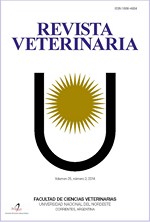Study of the seroprevalence, associated risk factors and the haematological values of infected Chlamydia abortus small ruminants in Benin Republic
DOI:
https://doi.org/10.30972/vet.3427055Keywords:
Serological, risk factors, Chlamydia abortus, hematological parameters, BeninAbstract
Chlamydia abortus is one of the causative agents. The aim of this study was to determine for the first time the serological prevalence and hematological parameters in small ruminants positive for Chlamydia abortus in Benin, mainly in the department of Ouémé. It covered five sites, namely Akpro-Missérété, Avrankou, Adjarra, Sèmè-Kpodji and Dangbo in the Ouémé department. A total of 385 sera (200 sheep and 185 goats) from subjects showing signs of reproductive loss were tested using the indirect Elisa method. Of the 385 sera tested, 30 (7,79%) were positive for Chlamydia abortus. Similarly, the blood of animals tested positive was analyzed for hematological parameters using Sysmex XN-Series automated blood analyzer. Different variations with significant differences in some hematological parameters of the red line and those of the white line, depending on the study sites, species, age and physiological stage of the animals (hemoglobin, mean corpuscular volume for the red line at the sites, lymphocytes and basophils for the white line at the sites; hemoglobin for the red lineage and lymphocytes for the white lineage at species level; lymphocytes at age level; lymphocytes, monocytes and basophils for the white lineage at physiological stage level) were observed in animals suffering from C. abortus.
Downloads
References
Adeyeye AA, Ate I. Blood Profile of ewes during third trimester of pregnancy and lactation. December 2017.
Aiche S, Smail F, Chikhaoui M, Abdelhadi S. Factors Influencing the Hematological Parameters in Ewes of the Rembi Breed during Late Pregnancy in Tiaret Region, West of Algeria. Alexan J of Vet Scie. 2020; 66(1): 111.
Bezerra LR, Oliveira WDC, Silva TPD, Torreão JNC, Marques CAT, Araújo MJ, Oliveira RL. Comparative hematological analysis of Morada Nova and Santa Inês ewes in all reproductive stages. Pesqui Vet Brasil. 2017; 37(4): 408-414.
Campos-Hernández E, Vázquez-Chagoyán JC, Salem AZM, Saltijeral-Oaxaca JA, Escalante-Ochoa C, López-Heydeck SM, de Oca-Jiménez RM. Prevalence and molecular identification of Chlamydia abortus in commercial dairy goat farms in a hot region in Mexico. Tropical Anim Heal and Produc. 2014; 46(6): 919-924.
Casanova JL, Abel L. Lethal Infectious Diseases as Inborn Errors of Immunity: Toward a Synthesis of the Germ and Genetic Theories. Annual Review of Pathology: Mechanisms of Disease. 2021; 16: 23-50.
Cihan H, Temizel EM, Yilmaz Z, Ozarda Y. Koyunlarda doğum öncesi ve sonrası serum demir durumu ve hematolojik endekslerle ılişkisi. Kafkas Universitesi Veteriner Fakultesi Dergisi. 2016; 22(5): 679-683.
Čislákován L, Monika H, Kováčová D, Štefančíková A. Occurrence of Antibodies Against Chlamydophila Abortus in Sheep. Ann Agric Environ Med. 2007; 14: 243-245.
Dellmann J, Eurell A, Brian L, Frappier C. Textbook of Veterinary Histology; Sixth Edition. 1987.
El-Malky OM, Mostafa TH, Ibrahim NH, Younis FE, Abdel-Salaam AM and Tag-El–Din, HA. Comparison between productive and reproductive performance of Barki and Ossimi ewes under Egyptian conditions. Egypt J of Sheep Goat Sciences. 2019; 14(1): 61-82.
Essig A, Longbottom D. Chlamydia abortus: New Aspects of Infectious Abortion in Sheep and Potential Risk for Pregnant Women. Current Clin Microbiol Reports. 2015; 2(1): 22-34.
Gravena K, Sampaio RCL, Martins CB, Dias DPM, Orozco CAG, Oliveira JV, Lacerda-Neto JC. Parâmetros hematológicos de jumentas gestantes em diferentes períodos. Arqui Brasil de Medic Vet e Zootec. 2010; 62(6): 1514-1516.
Kifouly AH, Okunlola M, Boko KC, Alowanou G, Challaton KP. Ovine enzootic abortion disease seroprevalence in small ruminants around the world: a systematic review. 2023; 1-13.
Lenzko H, Moog U, Henning K, Lederbach R, Diller R, Menge C, Sachse K, Sprague LD. High frequency of chlamydial co-infections in clinically healthy sheep flocks. BMC Vet Research. 2011; 7-29.
Sánchez-Rocha L, Arellano-Reynoso B, Hernández-Castro R, Palomares-Resendiz G, Barradas-Piña F, Díaz-Aparicio E. Presencia de Chlamydia abortus en cabras con historial de abortos en México. Abanico vet [revista en la Internet]. 2021; 11: e118.
Mamlouk A, Guesmi K, Ouertani I, Kalthoum S, Selmi R, Ben-Aicha E, Bel-Haj Mohamed B, Gharbi R, Lachtar M, Dhaouadi A, Seghaier C, Messadi L. Seroprevalence and associated risk factors of Chlamydia abortus infection in ewes in Tunisia. Compar Immunol, Microbiol and Infec Dis. 2020; 71(05): 10-15.
Masala G, Porcu R, Sanna G, Tanda A, Tola S. Role of Chlamydophila abortus in ovine and caprine abortion in Sardinia, Italy. Vet Res Comm. 2005; 29(1): 117-123.
Mensah SEP, Ahoyo NA, Oluwole FA. Innovation Opportunities in the Small Ruminants livestock sector in Benin. 2017.
Nazifi S, Gheisari HR, Shaker F. Serum lipids and lipoproteins and their correlations with thyroid hormones in clinically healthy goats. Vet Arhiv. 2005; 72(5): 249-257.
Osman KM, Ali HA, Elakee JA, Galal HM. Chlamydophila psittaci and Chlamydophila pecorum infections in goats and sheep in Egypt. OIE Revue Scientifique et Technique. 2011; 30(3): 939-948.
Plaza Cuadrado AS, Hernandez-Padilla EE, Rugeles-Pinto CC, Vergara-Garay OD, Herrera-Benavides YM. Perfil hematológico durante la gestación de Ovinos de Pelo Criollos (Ovis aries) en el departamento de Córdoba, Colombia. Revista Colomb de Ciencia Animal - RECIA. 2019; 11(1).
Research Animal Resources. Hematological Reference values in small ruminants. 2009.
Robertson A, Handel I, Sargison ND. General evaluation of the economic impact of introduction of Chlamydia abortus to a Scottish sheep flock. Vet Rec Case Reports. 2018; 6(3): 2016-2019.
Roubies N, Panousis N, Fytianou A, Katsoulos PD, Giadinis N, Karatzias H. Effects of age and reproductive stage on certain serum biochemical parameters of chios sheep under greek rearing conditions. J of Vet Med Series A: Physiology Pathology Clinical Medicine. 2006; 53(6): 277-281.
Sachse K, Hotzel H, Slickers P, Ellinger T, Ehricht R. DNA microarray-based detection and identification of Chlamydia and Chlamydophila spp. Molec and Cellu Probes. 2005; 19(1): 41-50.
Sattar A, Mirza RH. Haematological parameters in exotic cows during gestation and lactation under subtropical conditions. Pakis Vet J. 2009; 29(3): 129-132.
Schnee S. Veterinary infection biology: Molecular diagnostics and high-throughput strategies. Vet Infec Biol: Molecular Diagnostics and High-Throughput Strategies. 2014; 1247(2): 1-527.
Selim, A. Chlamydophila abortus infection in small ruminants: A review. Asian J of Anim and Vet Advan. 2016; 11(10): 587-593.
Seth-Smith HMB, Busó LS, Livingstone M, Sait M, Harris SR, Aitchison KD, Vretou E, Siarkou VI, Laroucau K, Sachse K, Longbottom D, Thomson NR. European Chlamydia abortus livestock isolate genomes reveal unusual stability and limited diversity, reflected in geographical signatures. BMC Genomics. 2017; 18(1): 1-10.
Sidibe S, Coulibaly KW, Sery A, Fofana M, Sidibe FKM. Prevalence of brucellosis, chlamydiosis and toxoplasmosis in small ruminants in Mali: results of an sero-epidemiological survey. 2019; 13(1): 1-9.
Tshiasuma KA, Ngoie K, Kaluendi CE, Kasereka SB. Impact de la gestation et de non gestation sur l’hématocrite, hémoglobine et les teneurs martiales chez la chèvre a Lubumbashi en zone tropicale. J of Applied Biosc; 2017; 122(1): 12241.
Waziri MA, Ribad AY, Sivachelvan N. Changes in the serum proteins, hematological and some serum biochemical profifi les in the gestation period in the Sahel goats. Vet Arhiv; 2010; 80(2): 215-224.
Yin L, Schautteet K, Kalmar ID, Bertels G, Driessche EV, Czaplicki G, Borel N, Longbottom D, Dispas M, Vanrompay D, Vlaanderen D, Park PS, Loan B. Prevalence of Chlamydia abortus in Belgian ruminants. 2014; 164-170.
Zezekalo VK, Kulynych SM, Polishchuk A, Kone MS, Avramenko N, Vakulenko YV, Chyzhanska NV. Prevalence of chlamydia-related organisms with zoonotic potential in farms of the poltava region. Wiad Lekar (Warsaw, Poland : 1960). 2020; 73(6): 1169-1172.
Downloads
Published
How to Cite
Issue
Section
License
LicenseRevista Veterinaria (Rev. Vet.) maintains a commitment to the policies of Open Access to scientific information, as it considers that both scientific publications as well as research investigations funded by public resources should circulate freely without restrictions. Revista Veterinaria (Rev. Vet.) ratifies the Open Access model in which scientific publications are made freely available at no cost online.











.jpg)
.jpg)



